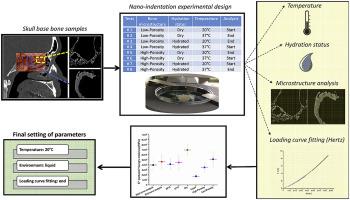Journal of the Mechanical Behavior of Biomedical Materials ( IF 3.9 ) Pub Date : 2020-06-29 , DOI: 10.1016/j.jmbbm.2020.103954 Valentin Favier 1 , Patrice Gallet 2 , Olivier Ferry 3 , Jean-Philippe Jehl 4

|
The mechanical properties of anterior skull base (ASB) bones are not well understood due to their complex geometry and deep location. However, it is of particular interest for skull base surgeons to appraise the force range they can apply during procedures and know what kind of haptic feedback a simulation device should produce in order to be realistic for trainees. The aim of this study was to establish a measurement protocol to set the level of hydration state, temperature and curve analysis method for spherical depth sensing nanoindentation of ASB bones. A definitive screening design method was used to test the different possible combinations of these factors. Two samples of ASB bones from the heads of two human body donors (two specimens) were selected according to their microstructure as assessed by micro-CT (microtomography): low-porosity (16.87%, sphenoid bone) and high-porosity (79.85%, ethmoid bone). Depth measurement series of 36 nanoindentations (n = 288) were performed on specimen 1 according to the L8 Taguchi orthogonal array to study the effect of temperature (two levels: 20 or 37 °C), hydration state (dry or immerged in physiological saline sodium chloride), and loading curve analysis according to the Hertzian contact theory (fitting at the start or at the end). The mean values of reduced Young's (E*) modulus varied significantly depending on the hydration status and bone microstructure. In order to obtain the physiological properties of ASB bones, we thus propose performing immersion tests. To simplify the experimentation protocol, future experiments must include a room temperature level and a fit of the curve at the end of the load. A validation series was performed on the second specimen to assess the set of parameters. The E* in dry bone gave mean values of 994.68 MPa, versus 409.79 MPa in immerged bones (p < 0.00001). This is the first time a study has been carried out on ASB bones, defining the experimental parameters related to physiological conditions.
中文翻译:

人类前颅底骨骼的球形深度感应纳米压痕:建立测试规程。
前颅底(ASB)骨骼的机械特性由于其复杂的几何形状和较深的位置而未被很好地理解。然而,颅底外科医师特别需要评估他们在手术过程中可以施加的力范围,并知道模拟设备应产生什么样的触觉反馈,以使受训者切合实际。这项研究的目的是建立一种测量协议,以设置水合状态水平,温度和曲线分析方法,用于ASB骨头的球形深度传感纳米压痕。确定性的筛选设计方法用于测试这些因素的不同可能组合。根据通过微型CT(显微断层扫描)评估的微观结构,从两个人体供体的头部(两个标本)的头部中选择了两个ASB骨头样品:低孔隙率(16.87%,蝶骨)和高孔隙率(79.85%,筛骨)。根据L8 Taguchi正交阵列对样品1进行了36个纳米压痕深度测量(n = 288),以研究温度(两个水平:20或37°C),水合状态(干燥或浸入生理盐水中)的影响氯化物),并根据赫兹接触理论(在开始或结束时拟合)进行载荷曲线分析。降低的杨氏模量(E *)的平均值根据水合状态和骨微结构而变化很大。为了获得ASB骨骼的生理特性,我们建议进行浸入测试。为了简化实验方案,未来的实验必须包括室温水平和负载末端曲线的拟合。在第二个样本上执行了一系列验证,以评估参数集。干骨中的E *平均值为994.68 MPa,而浸入骨中的E *平均值为409.79 MPa(p <0.00001)。这是首次对ASB骨骼进行研究,以定义与生理状况有关的实验参数。



























 京公网安备 11010802027423号
京公网安备 11010802027423号